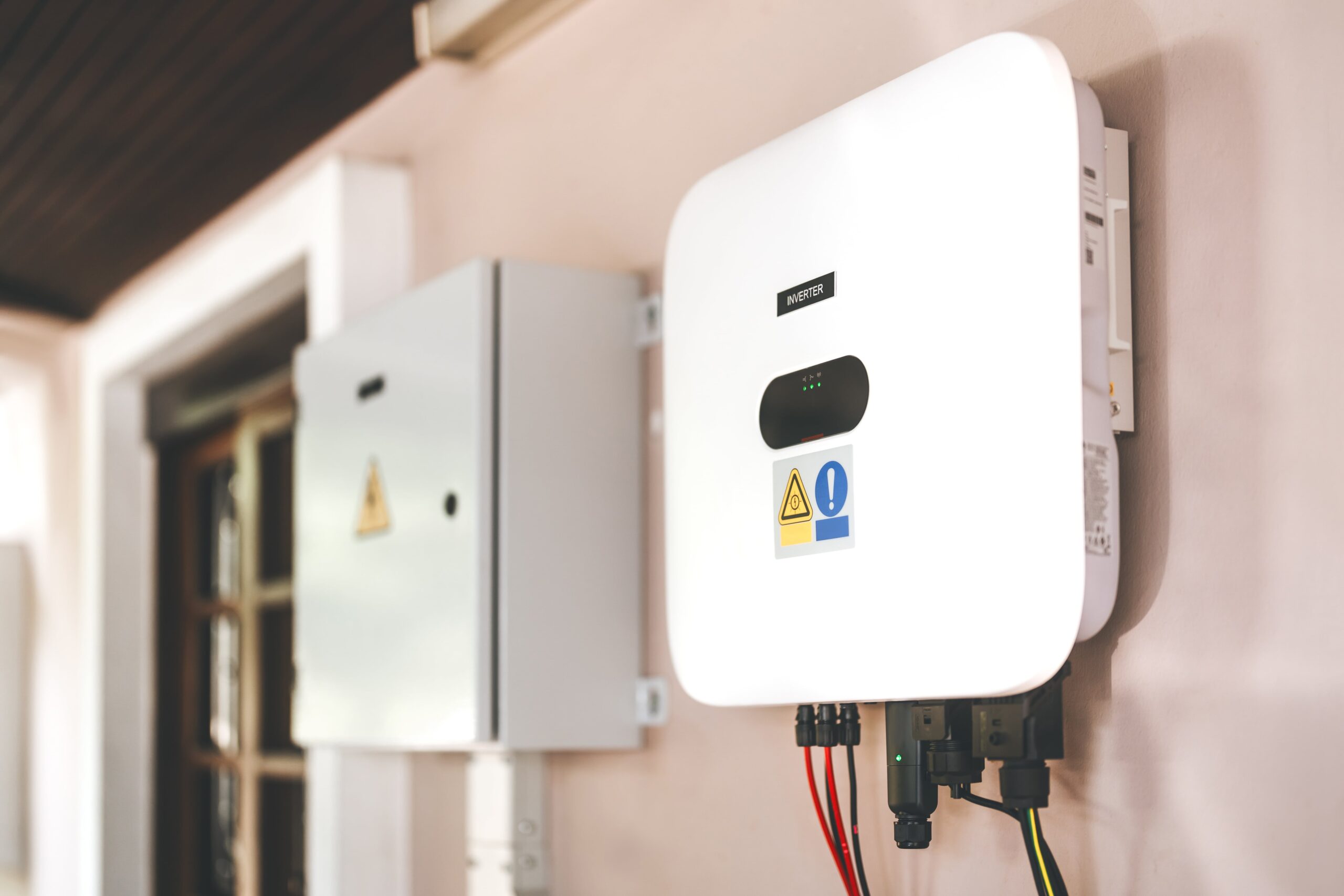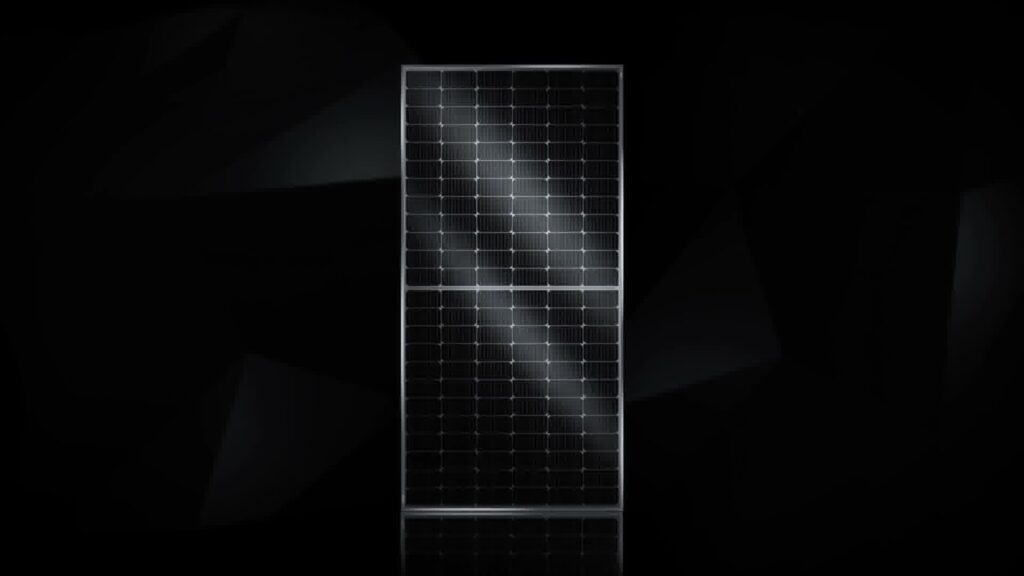Solar Inverters
HOME OF THE TOP SOLAR INVERTERS IN MELBOURNE FOR RELIABLE ENERGY & COST EFFICIENCY
A solar inverter serves as the essential intermediary between your solar panels and your home’s electrical system. It’s like the conductor of an orchestra, ensuring that all the solar energy your panels generate flows smoothly into your home to power your appliances. If there’s any extra energy produced, it’s seamlessly directed back to the mains grid. Plus, it’s not just a simple box of electronics; it’s equipped with crucial safety features like Anti-Islanding Protection, which safeguards your system and prevents accidents.
Given its pivotal role, selecting the right solar inverter is paramount. You’ll want one that can handle the task efficiently and delivers top-notch performance without breaking the bank.

Types of Solar Inverters

There are several types of solar inverters that exist, and it’s important to consider which type of inverter or inverters best fits your solar power solution.
Let’s explore each type:
Types of Solar Inverters
Types of Solar Inverters
There are several types of solar inverters that exist, and it’s important to consider which type of inverter or inverters best fits your solar power solution.
Let’s explore each type:
String Inverters:
This type reigns as the go-to choice for residential solar setups. With the exception of Enphase, most residential installations utilise string inverters. Typically mounted on walls near your electricity switchboard box, they earn their name by connecting strings of solar panels. While usually close to the switchboard, they might be placed at a distance depending on the installation scenario.
Central Inverters:
Reserved for large-scale solar systems, central inverters are colossal units designed for installations boasting hundreds of kilowatts to megawatts of capacity. These industrial behemoths resemble oversized metal cabinets and are solely deployed in vast commercial setups or utility-scale solar farms.
Micro Inverters:
These diminutive devices, roughly the size of a paperback book, operate on a one-to-one basis with solar panels. Offering individual optimisation for each panel, they excel in maximising energy output, particularly in shaded conditions. Although modern string inverters are improving in this aspect, microinverters still shine in certain scenarios. Enphase stands out as a top contender in this category.
Optimised String Inverters:
Similar to microinverters in performance benefits, optimiser-based systems employ a different technological approach. Attachable to the back of each solar panel, optimisers enhance output under various conditions. While the likes of Huawei optimisers necessitate optimisation for every panel, Tigo optimisers offer a cost-effective solution by not requiring this for every panel, making them advantageous for situations with limited shade.
Hybrid Inverters:
Also referred to as multi-mode inverters, hybrid inverters facilitate the integration of batteries into solar systems. Employing ‘DC coupling’, these devices manage battery charging and discharging seamlessly. Although the Australian market currently offers a limited selection of hybrid inverters, this is expected to expand with the rising popularity of battery storage.
Battery Inverters:
For those looking to retrofit batteries into existing solar systems or maintain separate battery setups, a standalone battery inverter is an effective albeit pricey option. Converting battery power to 230V AC, it integrates seamlessly into your home switchboard, reducing or potentially eliminating reliance on grid power.
What to consider when choosing your solar inverter
What to consider when choosing your solar inverter
Is it Suitable and Certified for Australian Use
When selecting a solar inverter, the primary consideration is its compliance with the relevant Australian Standard (AS4777). You can swiftly verify this by consulting the Clean Energy Council’s list of approved products. All grid-connected solar inverters certified for Australia should be listed there. If the one you’re eyeing isn’t on the list, it’s a red flag (unless you thrive on risk!). Moreover, for your solar system to qualify for Australia’s major solar subsidy, it must feature an inverter from the approved products list at the time of installation. Additionally, it’s wise to assess the credibility and experience of the manufacturer behind the product.
What's the Price Tag in 2024?
Determining the cost of grid-connected inverters in 2024 can be tricky as they’re predominantly bundled with solar power system packages. Typically, this component constitutes around 20%of the total system cost. For instance, budget single-phase 5kW solar inverters, like Goodwe, start at $1,000, while premium models such as Fronius or SMA can fetch upwards of $2,000. Keep in mind, opting for a 3-phase 5kW inverter adds around $500 or more to these prices. Remember, never sacrifice quality for the sake of saving a few bucks; investing in a reputable brand ensures longevity and reliability, vital traits for enduring Australia’s demanding conditions.
What's the Optimal Solar Inverter Size?
Choosing the right size solar inverter can be puzzling. Generally, the inverter should handle the maximum power your solar system can generate. However, due to panel losses, the inverter’s capacity (in AC kW) can be up to 25% to 30% less than the panel array’s capacity. Therefore, panel capacity can exceed inverter capacity by up to one-third. It’s crucial to ensure your inverter’s DC input matches your solar panels’ output. Consider potential future expansions cautiously, as technological advancements may render your current panels obsolete, necessitating a new inverter.
Is it Weatherproof and Durable?
Most grid-connected inverters boast weatherproofing (typically IP65 rated), allowing placement in areas exposed to the elements. However, some may require additional weatherproofing measures, such as enclosures, if placed in harsh environments. Optimal protection from heat and weather ensures optimal performance and longevity, a crucial aspect often stipulated in warranties. We, at 365 Solar Australia, only install solar inverters that are made for the harshest conditions Australia would experience.
What's the Warranty Like?
A solar inverter’s lifespan ranges from 10 to 20 years, with warranties typically spanning 5 to 12 years. Manufacturers may offer service warranty extensions for additional coverage. Factor in warranty duration alongside other system features to make an informed decision.
Is it Expandable?
Considering future expansions? Multiple MPPT inverters offer expandability, allowing the addition of extra panels down the line. However, it’s usually more practical to install all desired panels initially or opt for a separate solar system for expansion.
What About Display and Monitoring?
Most inverters feature display lights indicating operational status and digital displays showing energy production data. Data logging enables remote monitoring via computer or smartphone, providing real-time insights into system performance. Remote monitoring is a valuable feature for keeping tabs on your system’s health and performance.
Assessing Efficiency
Inverter efficiency measures how effectively it converts solar panel-generated electricity into usable power. While higher efficiency is generally desirable, certain features like active cooling may slightly lower efficiency while increasing lifespan. Therefore, consider efficiency alongside other factors when evaluating inverter options.
What to consider when choosing your solar inverter

Is it Suitable and Certified for Australian Use
When selecting a solar inverter, the primary consideration is its compliance with the relevant Australian Standard (AS4777). You can swiftly verify this by consulting the Clean Energy Council’s list of approved products. All grid-connected solar inverters certified for Australia should be listed there. If the one you’re eyeing isn’t on the list, it’s a red flag (unless you thrive on risk!). Moreover, for your solar system to qualify for Australia’s major solar subsidy, it must feature an inverter from the approved products list at the time of installation. Additionally, it’s wise to assess the credibility and experience of the manufacturer behind the product.

What's the Price Tag in 2024?
Determining the cost of grid-connected inverters in 2024 can be tricky as they’re predominantly bundled with solar power system packages. Typically, this component constitutes around 20%of the total system cost. For instance, budget single-phase 5kW solar inverters, like Goodwe, start at $1,000, while premium models such as Fronius or SMA can fetch upwards of $2,000. Keep in mind, opting for a 3-phase 5kW inverter adds around $500 or more to these prices. Remember, never sacrifice quality for the sake of saving a few bucks; investing in a reputable brand ensures longevity and reliability, vital traits for enduring Australia’s demanding conditions.
What's the Optimal Solar Inverter Size?
Choosing the right size solar inverter can be puzzling. Generally, the inverter should handle the maximum power your solar system can generate. However, due to panel losses, the inverter’s capacity (in AC kW) can be up to 25% to 30% less than the panel array’s capacity. Therefore, panel capacity can exceed inverter capacity by up to one-third. It’s crucial to ensure your inverter’s DC input matches your solar panels’ output. Consider potential future expansions cautiously, as technological advancements may render your current panels obsolete, necessitating a new inverter.
Is it Weatherproof and Durable?
Most grid-connected inverters boast weatherproofing (typically IP65 rated), allowing placement in areas exposed to the elements. However, some may require additional weatherproofing measures, such as enclosures, if placed in harsh environments. Optimal protection from heat and weather ensures optimal performance and longevity, a crucial aspect often stipulated in warranties. We, at 365 Solar Australia, only install solar inverters that are made for the harshest conditions Australia would experience.
What's the Warranty Like?
A solar inverter’s lifespan ranges from 10 to 20 years, with warranties typically spanning 5 to 12 years. Manufacturers may offer service warranty extensions for additional coverage. Factor in warranty duration alongside other system features to make an informed decision.
Is it Expandable?
Considering future expansions? Multiple MPPT inverters offer expandability, allowing the addition of extra panels down the line. However, it’s usually more practical to install all desired panels initially or opt for a separate solar system for expansion.
What About Display and Monitoring?
Most inverters feature display lights indicating operational status and digital displays showing energy production data. Data logging enables remote monitoring via computer or smartphone, providing real-time insights into system performance. Remote monitoring is a valuable feature for keeping tabs on your system’s health and performance.
Determining the cost of grid-connected inverters in 2024 can be tricky as they’re predominantly bundled with solar power system packages. Typically, this component constitutes around 20%of the total system cost. For instance, budget single-phase 5kW solar inverters, like Goodwe, start at $1,000, while premium models such as Fronius or SMA can fetch upwards of $2,000. Keep in mind, opting for a 3-phase 5kW inverter adds around $500 or more to these prices. Remember, never sacrifice quality for the sake of saving a few bucks; investing in a reputable brand ensures longevity and reliability, vital traits for enduring Australia’s demanding conditions.
Choosing the right size solar inverter can be puzzling. Generally, the inverter should handle the maximum power your solar system can generate. However, due to panel losses, the inverter’s capacity (in AC kW) can be up to 25% to 30% less than the panel array’s capacity. Therefore, panel capacity can exceed inverter capacity by up to one-third. It’s crucial to ensure your inverter’s DC input matches your solar panels’ output. Consider potential future expansions cautiously, as technological advancements may render your current panels obsolete, necessitating a new inverter.
Most grid-connected inverters boast weatherproofing (typically IP65 rated), allowing placement in areas exposed to the elements. However, some may require additional weatherproofing measures, such as enclosures, if placed in harsh environments. Optimal protection from heat and weather ensures optimal performance and longevity, a crucial aspect often stipulated in warranties. We, at 365 Solar Australia, only install solar inverters that are made for the harshest conditions Australia would experience.
A solar inverter’s lifespan ranges from 10 to 20 years, with warranties typically spanning 5 to 12 years. Manufacturers may offer service warranty extensions for additional coverage. Factor in warranty duration alongside other system features to make an informed decision.
Considering future expansions? Multiple MPPT inverters offer expandability, allowing the addition of extra panels down the line. However, it’s usually more practical to install all desired panels initially or opt for a separate solar system for expansion.
Most inverters feature display lights indicating operational status and digital displays showing energy production data. Data logging enables remote monitoring via computer or smartphone, providing real-time insights into system performance. Remote monitoring is a valuable feature for keeping tabs on your system’s health and performance.
Inverter efficiency measures how effectively it converts solar panel-generated electricity into usable power. While higher efficiency is generally desirable, certain features like active cooling may slightly lower efficiency while increasing lifespan. Therefore, consider efficiency alongside other factors when evaluating inverter options.
Assessing Efficiency
Inverter efficiency measures how effectively it converts solar panel-generated electricity into usable power. While higher efficiency is generally desirable, certain features like active cooling may slightly lower efficiency while increasing lifespan. Therefore, consider efficiency alongside other factors when evaluating inverter options.

Solar Panel Brands we Work With

Although we have access to just about every inverter brand available in Australia, we, absolutely, only work with and install inverter brands and inverters that have a proven track record of being reliable and of exceptional quality. The following are some of the brands we work with.
Solar Inverter Brands we Work With
Solar Inverter Brands we Work With
Although we have access to just about every inverter brand available in Australia, we, absolutely, only work with and install inverter brands and inverters that have a proven track record of being reliable and of exceptional quality. The following are some of the brands we work with.
Enphase
A microinverter system perfect for home.
Fronius and SMA
The most premium string inverter systems on the market.
Sungrowand Delta
Premium, cost-effective, energy-efficient premium solar inverter options.
Enphase
A microinverter system perfect for home.

A microinverter system perfect for home.
Fronius and SMA
The most premium string inverter systems on the market.

The most premium string inverter systems on the market.
Sungrowand Delta
Premium, cost-effective, energy-efficient premium solar inverter options.

Premium, cost-effective, energy-efficient premium solar inverter options.
Goodwe, SolisandGrowatt
Pocket-friendly, high-performing options for your residences.

Pocket-friendly, high-performing options for your residences.
Canadian Solar
One of the best brands and great value for money.
Longi Solar
Great value for panels that can be compared to the most premium brands.
Goodwe, SolisandGrowatt
Pocket-friendly, high-performing options for your residences.
Canadian Solar
One of the best brands and great value for money.
Longi Solar
Great value for panels that can be compared to the most premium brands.
Speak to our experts about choosing the perfectsolar inverters for your home or business, today
Speak to our experts about choosing the perfect solar inverters for your home or business, today !
Enphase

54HL4-(V)
Enphase
Lorem ipsum dolor sit amet, consectetur adipiscing elit. Ut elit tellus, luctus nec ullamcorper mattis, pulvinar dapibus leo.
